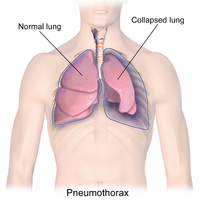
Photo from wikipedia
BACKGROUND: We present longitudinal data regarding the outcomes and evolution of mechanical thrombectomy (MT) using a direct aspiration first pass technique. OBJECTIVE: To evaluate the impact of increasing aspiration catheter… Click to show full abstract
BACKGROUND: We present longitudinal data regarding the outcomes and evolution of mechanical thrombectomy (MT) using a direct aspiration first pass technique. OBJECTIVE: To evaluate the impact of increasing aspiration catheter size. METHODS: This is a planned analysis of a prospective cohort study that enrolled all patients who underwent a direct aspiration first pass technique MT in a comprehensive stroke center from January 2013 to December 2020. We did exploratory analysis of the characteristics and outcomes of patients who had intracranial internal carotid artery or M1 segment of middle cerebral artery occlusion based on the aspiration catheter bore size (small [041, 054, 058, and 060 inch] vs medium [0.064 and 0.068 inch] and medium vs large [0.071, 0.072, and 0.074 inch]). RESULTS: During the 8-year study period, a total of 1004 patients were included. Median age was 69 years, 49% were female patients, and 60.6% were White. Symptomatic hemorrhagic transformation was observed in 47 patients (4.7%), and 366 patients (36.5%) achieved the modified Rankin scale of 0 to 2 at 90 days after the stroke. For patients with intracranial internal carotid artery or M1 occlusion, medium-bore aspiration catheters were more likely to achieve successful recanalization after first aspiration attempt (63.9% vs 51.4%, P = .015) and had a faster groin-to-reperfusion time (16 vs 20 minutes, P = .001) when compared with small-bore catheters. However, these differences were not significant when comparing medium-bore with large-bore catheters. CONCLUSION: Medium-bore catheters had better performance measures compared with small-bore catheters. However, large-bore catheters did not show significantly better performance results that suggest a plateau effect.
Journal Title: Neurosurgery
Year Published: 2022
Link to full text (if available)
Share on Social Media: Sign Up to like & get
recommendations!